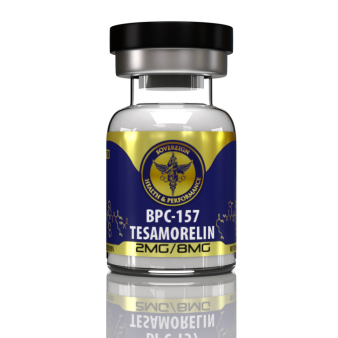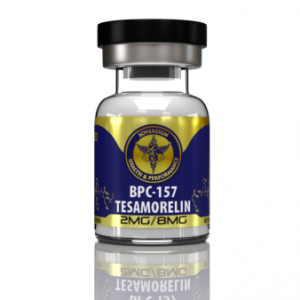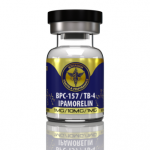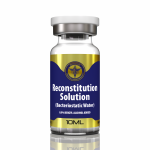

BPC-157 & Tesamorelin Blend
$119.00 Original price was: $119.00.$99.00Current price is: $99.00.
Research Only Purposes
- Description
- Quality Documentation
- Additional information
Description
🔬 BPC-157 + Tesamorelin: Exploring Complementary Mechanisms in Tissue Repair and Regeneration
BPC-157 and Tesamorelin are two peptides of growing interest in scientific research for their distinct but potentially complementary biological properties.
While BPC-157 has been primarily studied in preclinical models of tissue healing and angiogenesis, Tesamorelin is a clinically studied analog of growth-hormone–releasing hormone (GHRH), approved for specific medical use in lipodystrophy.
Together, these compounds represent converging areas of inquiry—linking cellular repair mechanisms with endocrine regulation of growth and metabolism.
This article summarizes current findings from peer-reviewed studies and highlights future areas of investigation. All information is for educational and research purposes only.
🧬 What Are BPC-157 and Tesamorelin?
BPC-157 (Body Protection Compound-157)
BPC-157 is a synthetic 15-amino-acid fragment derived from a naturally occurring protective protein found in human gastric juice.
Experimental data suggest it supports:
-
Angiogenesis: formation of new microvessels in response to injury
-
Fibroblast and macrophage migration: recruitment of key healing cells
-
Collagen synthesis and organization: improved tissue structure
-
Cytoprotection: maintenance of gastric, vascular, and neural integrity
These effects have been observed primarily in rodent and in-vitro models of tendon, ligament, muscle, and intestinal injury.
Tesamorelin (Growth-Hormone–Releasing Factor [GRF] Analog)
Tesamorelin is a synthetic analog of human GHRH that binds to pituitary GHRH receptors, stimulating pulsatile growth hormone (GH) release and subsequent insulin-like growth factor-1 (IGF-1) elevation.
In clinical settings, Tesamorelin has been evaluated for:
-
Visceral adipose tissue reduction in patients with HIV-associated lipodystrophy
-
GH axis restoration in age-related or secondary deficiency states
-
Metabolic and body-composition effects related to improved lipid oxidation and protein synthesis
Tesamorelin’s mechanism is well defined through the GH-IGF-1 axis, whereas BPC-157’s actions are largely localized, paracrine, and angiogenic.
⚙️ Complementary Mechanisms Under Investigation
Although no clinical studies have directly examined the combined use of BPC-157 and Tesamorelin, several theoretical intersections have been proposed in the literature:
-
Growth-Factor Pathway Convergence
-
BPC-157 up-regulates vascular endothelial growth factor (VEGF) and activates ERK1/2 and AKT signaling.
-
Tesamorelin’s GH-IGF-1 induction activates PI3K-AKT and mTOR pathways.
-
Together, these cascades intersect at cell proliferation, angiogenesis, and protein synthesis, potentially supporting coordinated tissue remodeling.
-
-
Vascular and Endocrine Integration
-
BPC-157’s angiogenic modulation may enhance microcirculatory perfusion in healing tissues.
-
Tesamorelin’s systemic anabolic influence could provide metabolic substrates (amino acids, growth factors) for tissue regeneration.
-
Investigating how local vascular repair interacts with systemic GH signaling remains an open research question.
-
-
Inflammation and Oxidative Stress Regulation
-
Preclinical models indicate BPC-157 stabilizes nitric-oxide balance and reduces cytokine overexpression.
-
GH and IGF-1 pathways are known to influence oxidative stress and immune modulation.
-
The potential synergy between vascular homeostasis and hormonal recovery represents a promising area for translational study.
-
📊 Representative Research Findings
BPC-157
-
Huang T et al. demonstrated accelerated wound closure, angiogenesis, and collagen formation in rat skin burn models. J Physiol Pharmacol. 2015;66(2):265-272. PMID: 25995620.Chang CH et al. showed enhanced fibroblast migration and tendon outgrowth through FAK-paxillin signaling. J Appl Physiol. 2011;110(3):774-780. doi:10.1152/japplphysiol.00945.2010.
-
Japjec M et al. reported complete functional recovery of myotendinous junctions with normalization of nitric-oxide pathways. Biomedicines. 2021;9(11):1547. doi:10.3390/biomedicines9111547.
Tesamorelin
-
Falutz J et al. observed significant reduction of visceral adipose tissue and increased IGF-1 in adults with HIV-associated lipodystrophy. N Engl J Med. 2010;362(12):1073-1084. doi:10.1056/NEJMoa0905954.
-
Stanley TL et al. reported metabolic improvements without significant glucose impairment in extended use. J Clin Endocrinol Metab. 2019;104(11):5065-5077. doi:10.1210/jc.2019-00256.
-
Buchbinder N et al. described Tesamorelin’s selective lipolytic effects through GH-dependent mechanisms, distinguishing it from direct GH therapy. Endocr Pract. 2022;28(3):230-238.
🧩 Proposed Research Synergy
Future studies may investigate whether combining local repair peptides like BPC-157 with systemic GHRH analogs like Tesamorelin could provide additive or complementary effects on:
-
Angiogenesis and tissue perfusion following injury
-
Collagen maturation and extracellular-matrix remodeling
-
Metabolic support for healing tissues via enhanced amino-acid transport and GH-IGF-1 signaling
-
Normalization of nitric-oxide and inflammatory pathways in regenerative microenvironments
Such studies would require rigorous design, including placebo-controlled, double-blind human trials with biochemical, imaging, and histologic endpoints.
⚖️ Safety and Regulatory Context
-
BPC-157 has not been evaluated in human clinical trials sufficient for FDA approval; all current data are preclinical.
-
Tesamorelin is FDA-approved for HIV-related lipodystrophy but not for generalized GH deficiency, anti-aging, or tissue-repair purposes.
-
Both compounds are included on WADA’s list of prohibited substances for competitive sport due to their hormonal and regenerative properties.
-
Appropriate handling within laboratory or academic research settings requires adherence to regulatory standards for investigational compounds.
🔭 Future Areas of Investigation
-
Controlled human studies exploring localized vs. systemic healing effects when angiogenic and endocrine pathways are concurrently activated.
-
Comparative mechanistic research on how GH-IGF-1 signaling interacts with VEGF-mediated vascular remodeling.
-
Metabolic and mitochondrial studies examining the influence of Tesamorelin-induced GH on energy utilization within regenerating tissues.
-
Long-term safety assessments, focusing on glucose metabolism, cell-proliferation control, and angiogenic regulation in combined use.
Additional information
| CAS | 137525-51-0, 804475-66-9 |
|---|---|
| MG | 2/8 |
| Brand | Sovereign Health and Performance |








